Other names: Italian Cane Corso, Italian Mastiff
Cane Corso is a large breed, a descendant of the fighting dogs of Ancient Rome. For centuries, these intelligent and obedient dogs served their owners, guarding their homes, helping them in hunting and in the field.
CONTENTS:
- Brief information
- Key points
- Characteristics of the breed
- History of the Cane Corso breed
- Characteristics of the Cane Corso
- Appearance and special features of the breed
- Character of the Cane Corso
- Training and education
- Care and maintenance
- Health and diseases of the Cane Corso
- How to choose a puppy
- How much does a Cane Corso cost
What Was The Cane Corso Bred For?
Brief information
| Breed name: | 🐶 Cane Corso |
| Country of origin: | Italy |
| Weight: | males 45-50 kg, females 40-45 kg |
| Height (height at withers): | males 64-68 cm, females 60-64 cm |
| Life expectancy: | 9-11 years |

Cane corso dog
Key points
- This dog has excellent guard qualities. It considers the territory where the owner and his family live as its own space and guards it with special care.
- Cane Corso is not aggressive by nature, but if uninvited guests show up, they will certainly feel the harsh nature of the "Italian".
- Representatives of the breed are strong and hardy, are distinguished by intelligence and quick-wittedness, and need constant physical and mental activity.
- In a pack, Cane Corso shows dominant character traits, trying to dominate.
Some imperiousness of the dog can be a difficult test for inexperienced owners, so if you decide to get a four-legged friend for the first time, start with a representative of a different breed.

Cane Corso with puppies - Cane Corso can show aggression towards other dogs and animals, and in order to keep such emotions in check, puppies must be socialized from a very early age.
- Outwardly they look languid and unhurried, but this impression is deceptive. Like real "temperamental Italians", they willingly join in games, love to run and, in general, spend time actively.
- They get along well with children, becoming a reliable nanny for them. This is how the genes of their distant ancestors - shepherd dogs, for whom the owner and his family, including pets, were objects of control, make themselves known.
- Cane Corso are characterized by kindness and attentiveness, they are affectionate with the owner and demand reciprocity.

Black cane corso
The breed was developed by breeders in Italy
Being the fourteenth breed bred in Italy, Cane Corso are the pride and national treasure of this country.
The character of the dogs is a surprising combination of the dedication of shepherds and the courage of fighting breeds, and also reflects the lively temperament of the Italians themselves.
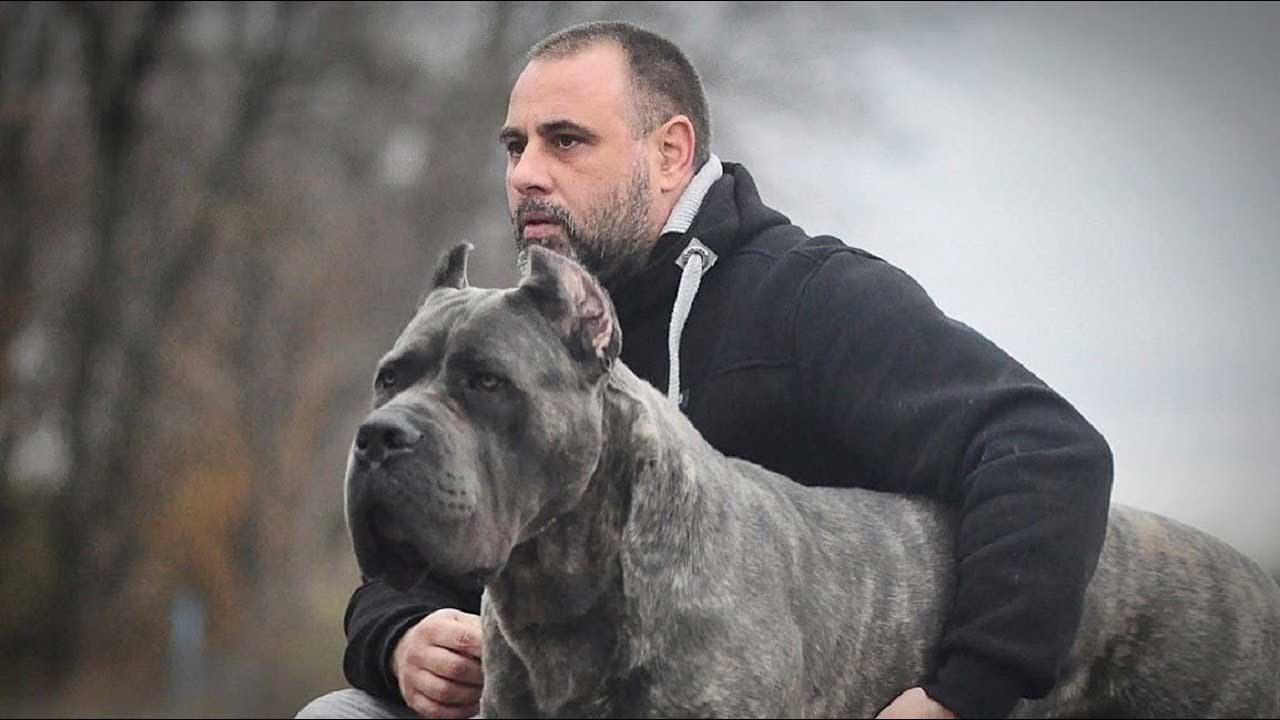
Blue brindle cane corso
Cane Corso - an unrivaled guard
Cane Corso are sensitive and intuitive, they are ready to protect the owner and his family at any time and in any situation, which makes them unrivaled guards. If a dog of this breed lives in your house, there is no need for alarm systems.
They will not meet a thief who has broken into the house with aggression, which is different from other guard dogs, but the robber will greatly regret meeting a native of the sunny Apennines. The Cane Corso reserves its aggressive reaction for the last resort, when it feels that a real threat is hanging over the owner and his property.

Cane Corso is friendly with children
Breed characteristics
| Aggression | Above average (Rating 4/5) | |
| Activity | High (Rating 4/5) | |
| Trainability | Easy (Rating 4/5) | |
| Shedding | Moderate (Rating 3/5) | |
| Grooming needs | Low (Rating 2/5) | |
| Friendliness | Friendly (Rating 4/5) | |
| Health | Good (Rating 4/5) | |
| Сost of keeping | Expensive (Rating 5/5) | |
| Attitude to loneliness | Short periods (Rating 2/5) | |
| Intelligence | Smart (Rating 4/5) | |
| Noise | Above average (Rating 4/5) | |
| Guard qualities | Excellent (Rating 5/5) | |
History of the Cane Corso breed
Cane Corso has a long and glorious history, counted for many centuries. Their most distant ancestors were Tibetan dogs of ancient times. In those harsh times, when it was necessary to defend against many enemies and wild animals, such dogs were especially valued.
These dogs still evoke genuine respect and even some kind of awe.
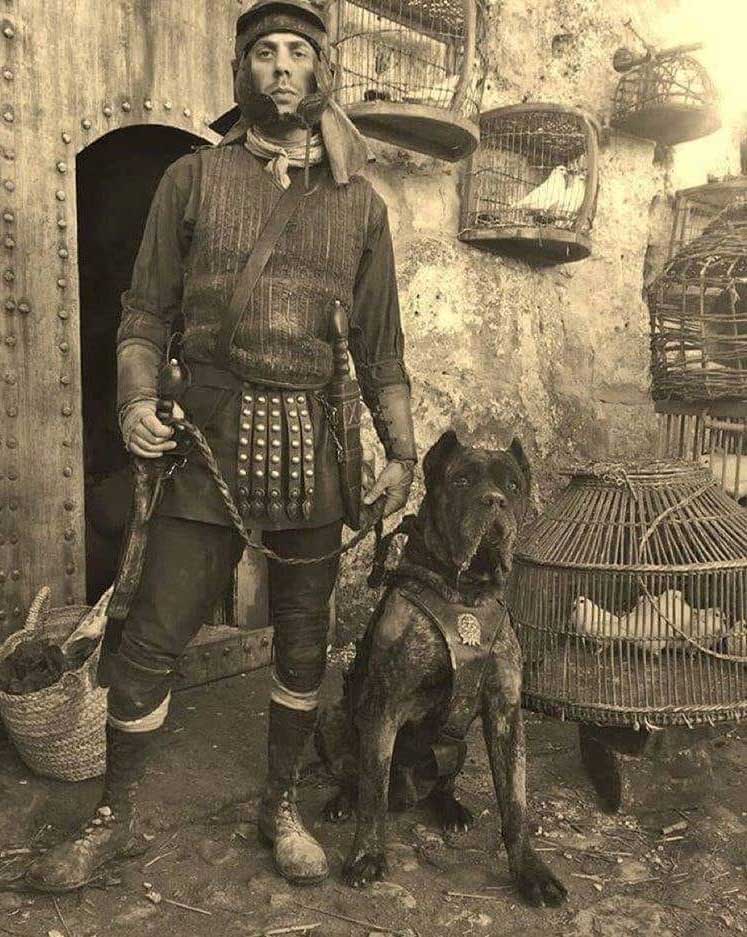
It is known that the first ancestor of modern "Italians" on the territory of modern Eurasia appeared 1 thousand years BC. It was an aggressive Tibetan dog, which was presented to the Chinese emperor, who appreciated such a skill in it as the ability to catch people.
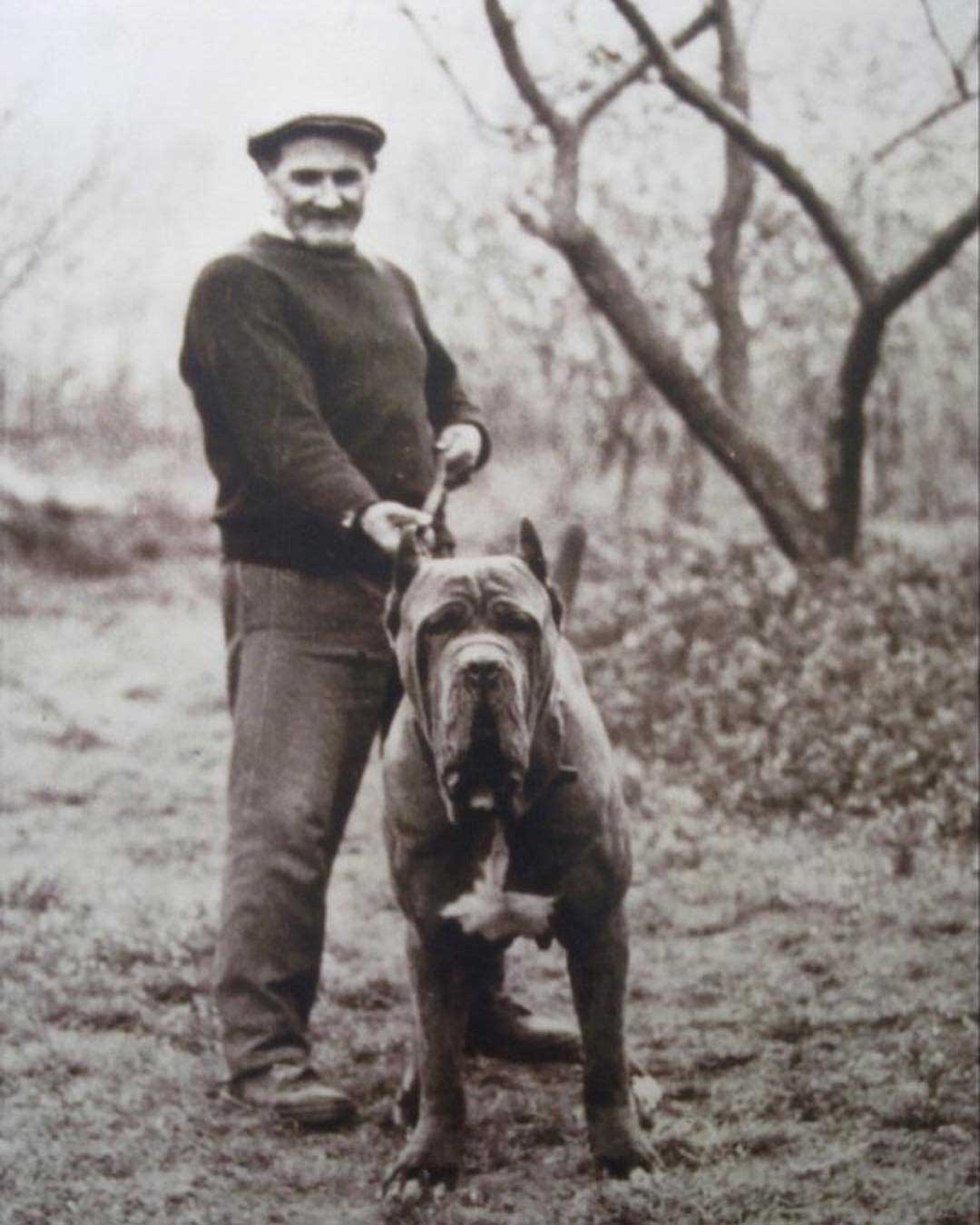
Since then, they began to spread quite quickly across the continent, becoming the ancestors of some other breeds.
New dogs were bred for very specific purposes. In the same Roman Empire, they were used for dog fights, in military campaigns and, of course, as guards.
The first written records of giant Corso dogs date back to the 14th-15th centuries. Documents discovered by historians say that they participated in hunts and baiting.
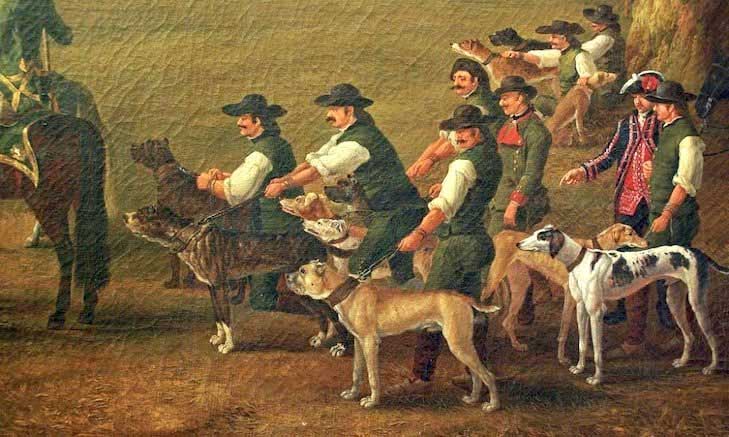 Cane Corso in an old painting
Cane Corso in an old painting
In some areas, these dogs were used for herding and guarding livestock. As for the official history of the breed, it is usually traced back to the heyday of the Roman Empire. Archaeological sites with multiple images of these majestic dogs have survived to this day.
Corso accompanied their owners on military campaigns, looked after slaves and guarded entire palace complexes. After the fall of Ancient Rome, dogs began to be crossed with Celtic greyhounds, thereby infusing the breed with "new blood".
At the same time, they began to be used less as fighting dogs, but for hunting, for guarding farmland and driving livestock. All this continued for a long time, so loyalty to one owner is literally in their blood, it is embedded at the genetic level.

The dogs' ability to perform a variety of tasks made the breed multi-purpose, which remains unchanged to this day. Since Cane Corso dogs have always been highly valued, the quality of their gene pool was carefully monitored.
However, despite this, sad pages in the history of the breed could not be avoided. During World War II, Cane Corso dogs, like many other breeds, were on the verge of extinction. These giants were actively used at the front, which, coupled with underfeeding and often hunger, undermined the breed.
But Cane Corso dogs did not disappear, and for this, humanity should be grateful to Giovanni Bonatti Nizzoli, who showed persistence and made titanic efforts to revive these proud, intelligent and majestic dogs.
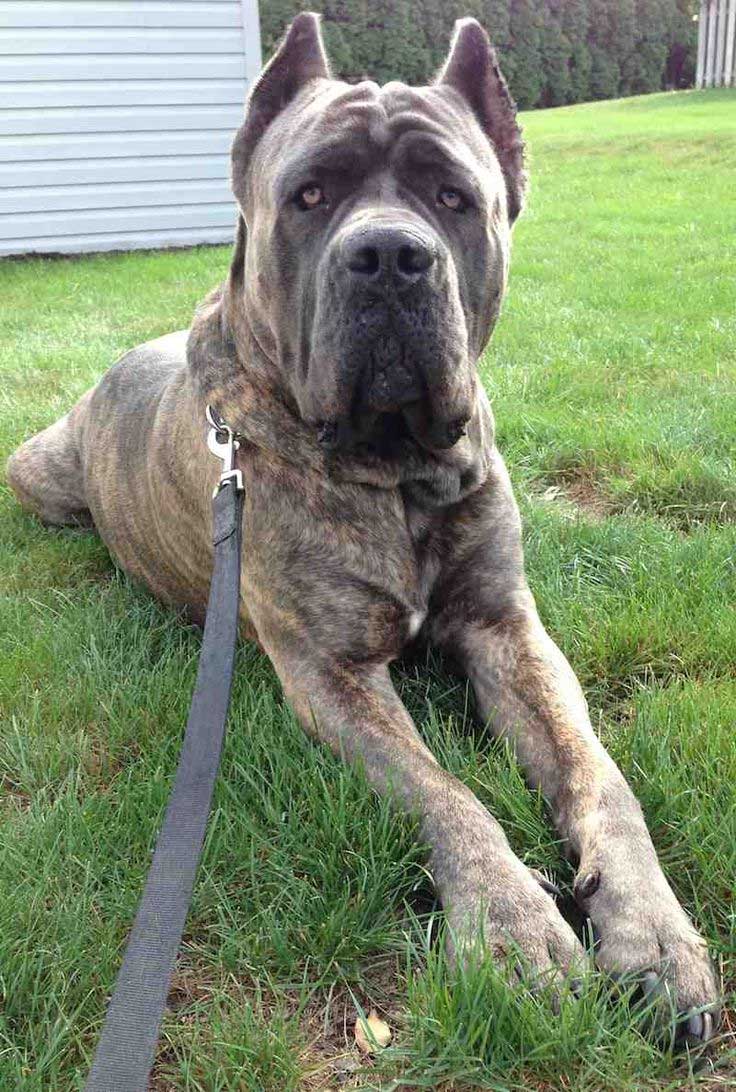
He received invaluable help from like-minded people who, in 1983, gathered all the purebred Cane Corso dogs that had somehow miraculously survived throughout Italy.
Four years later, a breed standard was issued – the first one approved at the official level. This document gave an accurate description of the dogs and emphasized the features that distinguished the Corso from other descendants of mastiffs.
Although the breed received pedigree registration only in 1994, before this event, more than 500 producers and several hundred puppies had received expert recognition and positive assessments from them.
Cane Corso Features
Guard qualities are genetically embedded in the Cane Corso, so they perform this function even without special training. The dog will guard the owner, his family members, as well as the entire house territory.

Cane Corso is a guard dog
This giant gets along well with pets, even with those who are not too happy about his appearance in the house. His "friends" can be not only other dogs, including small breeds, but also cats and even birds.
These dogs have balance in their blood. Seeing that the guest is friendly with the owner, the "Italian" will remain calm. He will not be active if he feels a hidden threat, but will make it clear that the situation is under his control.
The dog attacks only in two cases: if direct aggression is shown towards him or if he receives the appropriate command from the owner.
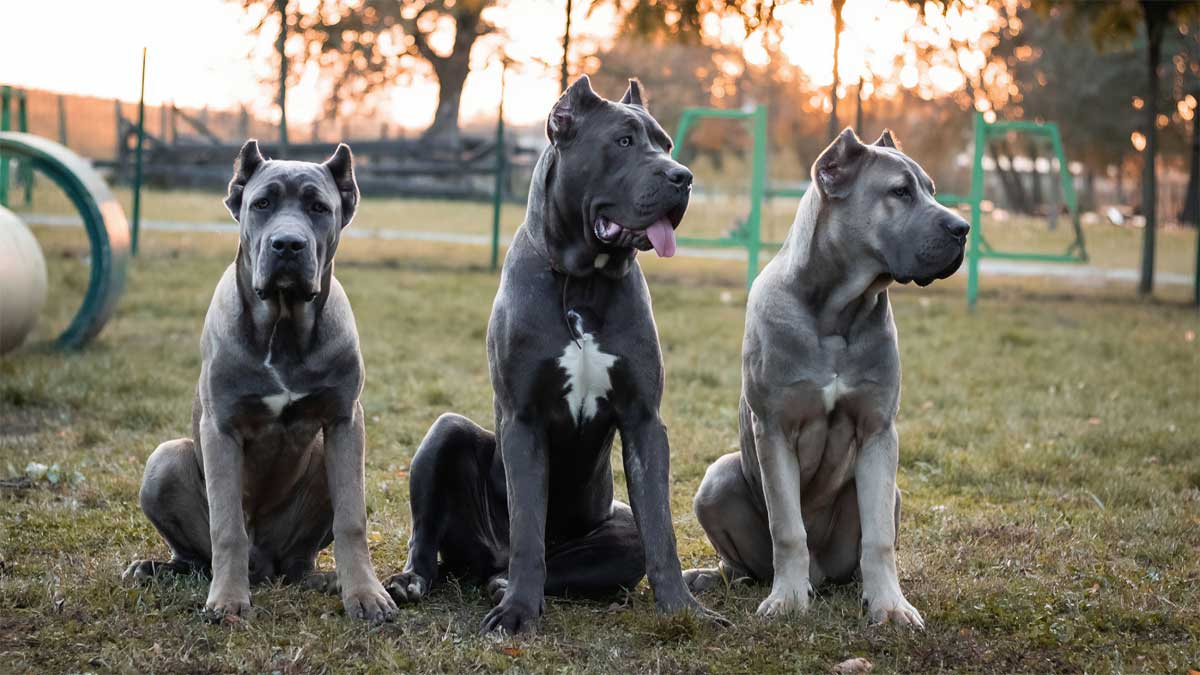
Cane Corso Family Protection Dogs
Cane Corso and attitude towards children
Corsos are especially careful with younger members of the family, this goes back to the times when they wandered with flocks and developed an instinct to protect everyone who is smaller and weaker. These large dogs will never hurt a child, even a stranger, but, on the contrary, will take care of him almost with maternal zeal.
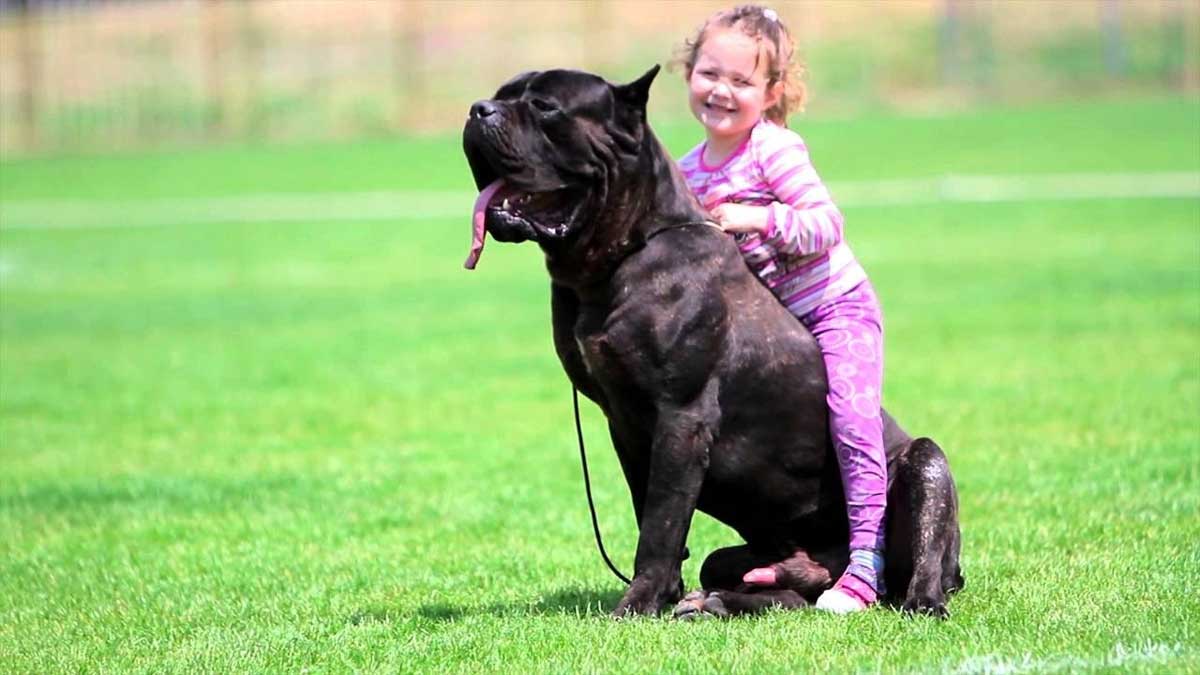
Cane Corso and small children
Children reciprocate these dogs and often involve them in their games, for example, in doctors and hairdressers. It is impossible to watch without affection and laughter how a little one “treats” a dog or tries to do his hair, and the Corso humbly endures.
True, at the very beginning he will try to slip away from the little “doctor”, but if he fails, then he meekly endures all the “procedures”.
During games, a Cane Corso can accidentally, completely without malicious intent, lightly push a child. If you are worried that another such push could cause the baby to fall, then command the dog “Sit!” or “Lie down!” and it will definitely do what is required, and the first time.
Appearance and special features of the breed
Cane Corso or Italian Mastiff is a large dog with prominent muscles. The body is characterized by the so-called stretched format, when the length is greater than the height at the withers.
The latter indicator is 64-68 cm for males, 60-64 cm for females. Adult dogs weigh, depending on gender, 45-50 kg and 40-45 kg, respectively. The size of the dog should not surprise, because the breed was bred for security, hunting and combat needs.
Cane Corso Italiano impresses with strength, beauty and power, they are incredibly charismatic. Representatives of this breed move gracefully, their gait reminiscent of panthers.
Being next to the dog, you feel protected and know for sure that you will not be betrayed. The originality of the Cane Corso, the features of their appearance and amazing skills have been passed down from generation to generation for many centuries.
From the Molossian Dogs, their closest ancestors, the Italian Mastiffs have retained a lot, but selection activities have made their own adjustments. These dogs are not only reliable bodyguards, but also, despite their stern appearance, loyal and kind friends.
General description
Cane Corso have an athletic build, their appearance gives them away as uncompromising guards and true defenders.
They look presentable and elegant at the same time: a powerful body, a broad chest, developed shoulders, a muzzle typical of all molossers, a confident gait. Dogs of this breed are mainly black, brown and brindle colors.
The character of the "Italian" consists of solid virtues: he is mentally balanced, predictable, easy to train, very devoted to his owner and never shows causeless aggression. Such qualities are inherent in many representatives of the molosser group, for example, the English bulldog and the Bordeaux mastiff.
If bad traits begin to be found in the dog's behavior, the reason should be sought in poor upbringing, but not in natural predisposition.
Head
The head of the Cane Corso is wider than long. It is covered with thick skin, there are no folds on the muzzle. The muzzle, in turn, is related to the skull in a ratio of 1:2, that is, it is short. But at the same time, it is wide and voluminous, square in shape, flat and strong.
Teeth
A dog of this breed has 42 teeth, they are white and strong. The jaws are large, powerful, curved. Due to the fact that the lower jaw protrudes slightly forward, the bite is characterized as a slight undershot.
Eyes
Oval in shape, have a wide spacing on the muzzle. Their color depends on the color of the dog, but the darker it is, the better. The eyelids have black pigmentation.
Ears
By nature, the ears of the Cane Corso are slightly large and widely spaced, with a tight fit to the head. Covered with smooth and shiny hair, they taper to the ends and hang down, fitting close to the dog's cheeks. They can be docked, giving the shape of an equilateral triangle.
Nose and lips
The nose is black and large, the nostrils are wide open. The lips are tight and not too drooping. The upper lips cover the lower jaw, thereby completely defining the lower part of the muzzle profile.
Neck
The neck of the Cane Corso is strong, muscular, proportional to the body, but not too voluminous, giving the dog some elegance. Its length is equal to the length of the head.
Body
The Cane Corso has a strong build, the body is somewhat longer than the height at the withers. The withers are clearly defined, they protrude above the long, wide and slightly sloping croup. The chest reaches the level of the elbows, it is wide and well developed. The back is straight, has pronounced muscles. The convexity of the ribs is moderate.
Tail
The Cane Corso's tail is naturally long and reaches the hocks, it is set high, thick at the base. It does not rise vertically or curl. The tail is docked at the fourth vertebra.
Limbs
The forelimbs are characterized by long, sloping and very developed shoulder blades. The shoulders and forearms are strong, the metacarpus and carpus are elastic. The front paws are of a cat type with elastic pads and strong claws. The paws are oval in shape, the toes are gathered into a lump.
The hind legs are wide and long at the hip, the back line of the thighs is convex. Strong shins and a slightly angular hock. Powerful and sinewy metatarsus. The hind legs are also oval, with elastic pads and strong claws, the toes are gathered into a lump.
Thanks to these characteristics, Cane Corso move with a wide stride, they have a large and sweeping trot.
Coat
The skin is thick and lies close to the body. The Cane Corso has a very thick coat, but with a sparse undercoat, short and shiny. If it is of medium length, devoid of stiffness and wavy, then this is a serious fault of the breed.
Color
Here the breed standard allows for significant diversity. In addition to the traditional black, light red, dark red and brindle colors, Cane Corso can be light gray, lead (medium gray) and slate (dark gray), as well as red (deer color).
Small white specks are allowed, but only on the chest, nose and ends of the paws.
Note: Red and brindle Cane Corsos should have a black or grey mask on their muzzle that does not extend beyond the line of the eyes.
Possible defects
If the longitudinal axes of the muzzle and skull converge, as well as the lateral surfaces of the muzzle, this is considered a serious defect. This also includes the parallel arrangement of the longitudinal axes of the muzzle and skull.
The following are considered breed-damaging defects: height below or above the norm, partial depigmentation of the nose, movements that constantly turn into an amble, scissor bite, a tail curled into a donut or standing vertically, an undershot bite with a significant deviation.
Disqualifying defects
Is your pet aggressive? This is a serious defect for which he will be disqualified. The same verdict will be given to a timid or frankly cowardly animal.
In general, any Italian Mastiff with very clearly expressed behavioral or physiological anomalies should be disqualified. These also include undershot bite, so-called ram's nose, sunken nose, squint, cataract, fragmentary or complete depigmentation of the eyelids, long or soft hair, with unacceptable coloring and large white spots.
A sign of health in Cane Corso is considered to be developed testicles of males. There are two of them, and they should be completely lowered into the scrotum.
Cane Corso character
Only those who do not know the breed at all or judge it by its rather formidable appearance can speak critically or with apprehension about these beautiful, intelligent "Italians". And those who know speak exclusively positively about the Cane Corso, because you will not find a more devoted, kind and good friend.
Among all other breeds, these natives of the Italian "boot" are called the golden mean, and there are many reasons for this. Cane Corso are not giants, but at the same time they are not small. They are always fit, and in order for your dog to always maintain good shape, its physical development must be given considerable attention.
These dogs are very smart by nature and are easy to train. The main condition is the right approach. Many owners are not confident in their teaching abilities, so they turn to professional dog handlers.
Cane Corso does look a bit stern, so if you walk around the city with it, many passers-by will probably want to cross the street. It is difficult for uninformed people to imagine that behind the mask of a ferocious beast hides a kind, affectionate and understanding creature.
Remember: sudden aggression is absolutely not inherent in these dogs. However, they do not let the people near the owner out of their sight and watch how he communicates with them.
Cane Corso are very playful and readily join in any entertainment. This playfulness is especially evident at a young age. Sometimes the dog is so carried away by the game that sometimes it does not respond to the owner's command, which is quite forgivable - well, who hasn't!
As they grow older, Italian Mastiffs become calm and measured. By nature, the dogs are not at all selfish. There is no such trait as jealousy in them.
If Cane Corso are so good-natured, playful, non-aggressive, then how do guard qualities fit in with all these traits? Very harmoniously and one does not interfere with the other. They react to danger quickly, almost with lightning speed. Strong jaws provide an iron grip, so a thief who has broken into your home will not be well off when meeting this dog.
In relation to uninvited guests, whom he perceives as violators of his territory, the dog can begin to act at his own discretion, sometimes even disobeying the owners.
For the sake of its owners, the Corso is ready to do everything. In the presence of this dog, strangers should refrain from sudden movements. No, it will not immediately pounce on you, but with its facial expressions it will show that it is not worth continuing. And a representative of this breed will never take anything from the hands of a stranger, including treats.
It is almost impossible to distract it from protecting the owner, members of his family or any object entering its territory. These dogs understand perfectly well who is theirs and who is a stranger. Sometimes it even seems that they can miraculously, intuitively predict the bad intentions of a person before he begins to show them, that is, the sense of danger in these dogs is excellently developed.
The Mastiff can begin to act long before the danger begins to really threaten its owners, trying in every possible way to warn them. Looking into the eyes of this smart dog, it is as if you are reading its thoughts. If Cane Corso could talk, then you probably wouldn't find a better conversationalist.
Many wealthy people get a dog of this breed for prestige (after all, Corso dogs are expensive), not really perceiving it as a full-fledged member of the family. For example, they can leave for a long time, leaving the dog in someone's care. This cannot be done, because these dogs experience separation, and especially betrayal, extremely painfully.
In the absence of the owner, the "Italian" can become sad, stop eating and simply die. A real owner who treats his pet with love will show him all his love in every possible way and will never leave him alone for a long time.
Training and education
The tendency to dominate is not in the character of the Cane Corso, which means that they are easy to train. Being docile by nature and naturally devoted to the owner, they recognize the latter's authority very quickly. But representatives of this breed are in no hurry to grow up.
Many owners, for various reasons, do not want to turn to the services of dog handlers (for example, because of the high cost of their services) and prefer to raise puppies themselves. What should you pay attention to in this case?
The process of raising a Cane Corso puppy should begin from the very first day of his appearance in the house. First of all, accustom the baby to basic cleanliness and toilet.
The most necessary commands are:
- "Come!",
- "No!",
- "Sit!",
- "Next!",
- "Stand!",
- "Lie down!",
- "Place!".
You should teach your pet these commands first of all. If you don't like something in your puppy's behavior, try to correct it, preferably at an early stage. Disobedience should not entail physical punishment. When walking with him in the park or outside the city, fill your free time with any sports training.
Dog training should take place on an empty stomach. This will stimulate it to accurately follow all commands in order to receive a reward - a tasty treat. Do not forget to praise your pet, which will be an additional expression of your love for him.
Note: strangers should not participate in the upbringing of a Cane Corso. All commands should be pronounced clearly and understandably. Be consistent in training, demand that your pet complete all tasks set before it.
Care and maintenance
It is believed that even small dogs, not to mention more or less large ones, can cause inconvenience to their owners in an ordinary city apartment. Cane Corso completely refute this established stereotype. Despite the fact that they are not small dogs, they do not need a lot of space due to their lack of mobility.
If you live in a private house, this does not mean that you can put your pet in a kennel and put it on a chain. By nature, "Italians" are too freedom-loving and need to be constantly near their owner. In addition, the dog's light undercoat is not able to warm it in severe frosts, so the Cane Corso should not be a "yard dweller".
You should regularly walk your pet, do not deprive it of the joy of active recreation. By going outside the home with your dog and changing the environment, you bring the necessary variety into its life, which has a positive effect on the nervous system and helps it not to weaken. At the same time, joint walks strengthen the mutual understanding between the owner and his four-legged friend.
You should walk with your dog for at least an hour at least twice a day. Cane Corso Italiano, like their fellow large breeds, are prone to diseases of the musculoskeletal system. If your pet is under two years old, do not burden it with long runs, not to mention frequently overcoming high barriers.
Daily care of the dog will not be difficult for you, and all thanks to its short hair and thin undercoat. It sheds twice a year, in spring and autumn, and this whole process is almost unnoticeable. It is also good that the Corso does not spread the dog smell around the house. True, it does drool, which worries the owners. For such cases, you need to have a towel on hand.
It is enough to comb the dog once or twice a week, using a rubber comb or massage glove. This will help not only to remove dead hair, but also to improve blood circulation. During the seasonal shedding period, it is recommended to comb it daily.
When bathing your pet, use a rubber glove, which will also help to get rid of dead hair faster. The dog's coat has a protective fatty film, and if the Corso is often bathed using various detergents, the film will wash off and the coat will become dull.
Bathing procedures for the dog should be arranged once a month or as soon as it gets very dirty. Experienced breeders recommend regular dry cleaning. Special dry shampoos are used for this purpose. You can buy them at any pet store.
The dog's ears need regular inspection so as not to miss the onset of a possible inflammation. They also need airing. Take hold of the hanging ends with your fingers and wave the ears like butterfly wings.
In healthy Cane Corso ears there is no excess sulfur, no brown discharge and, accordingly, no unpleasant odors. To remove accumulated dirt, use a dry cotton pad, without penetrating deep into the ear canal. If there is purulent or other discharge, you should definitely contact a veterinarian.
No less attention should be paid to the pet's teeth. To keep them healthy for many years, do not let him chew on excessively hard objects and especially not stones. Special treats and rope toys are used to clean the teeth. Plaque removers are applied to the surface of the latter.
But only a veterinarian can remove tartar. To prevent tartar formation, brush your dog's teeth three to four times a week, using a special toothpaste with a function of dissolving tartar-forming deposits.
The eyes also need regular examination. A healthy dog's organs of vision are shiny, devoid of tear ducts and secretions. Periodically rinse the Cane Corso's eyes with chamomile infusion, which will prevent souring. To wipe the eyes, use a damp, lint-free cloth, wiping each with a separate piece.
After walks, wipe your pet's paws with a damp cloth or wash them in the shower. Do not ignore the paw pads, which will help to detect cracks or wounds in a timely manner.
An antiseptic is used to treat them. Regular vegetable oil is used as a preventative measure against cracks. It is given to the dog one teaspoon per day, and is also regularly rubbed into the paw pads.
And, of course, do not forget about ticks and fleas, which can cause great harm to the health and life of your Cane Corso. However, you should not "do it yourself" in this important matter.
A veterinarian should select a remedy for ectoparasites based on the dog's age, weight and health. A schedule for treating the dog with the selected drug should be drawn up, which should be strictly followed.
Now about feeding the dog. You can give it both natural products and ready-made food, but only premium. The main advantage of ready-made food is that it saves time, but is expensive. Quality products are also not cheap, and you also have to spend time preparing them.
But in the process of cooking, you see what exactly the Cane Corso's diet is made up of, which cannot be said about ready-made food. Each type of feeding has its pros and cons, and it is up to you to decide which one is right for your pet. The main thing is that your dog’s health and well-being do not suffer as a result.
Important: Cane Corso dogs are not recommended to eat fatty meats (such as pork), smoked meats, spicy foods, river fish, fatty dairy products (sour cream, cottage cheese, cream), some cereals (millet and pearl barley due to their poor digestibility), fatty broths and liquid soups.
This list also includes various sweets, nuts, onions, garlic and cheap low-grade food.


Recent posts